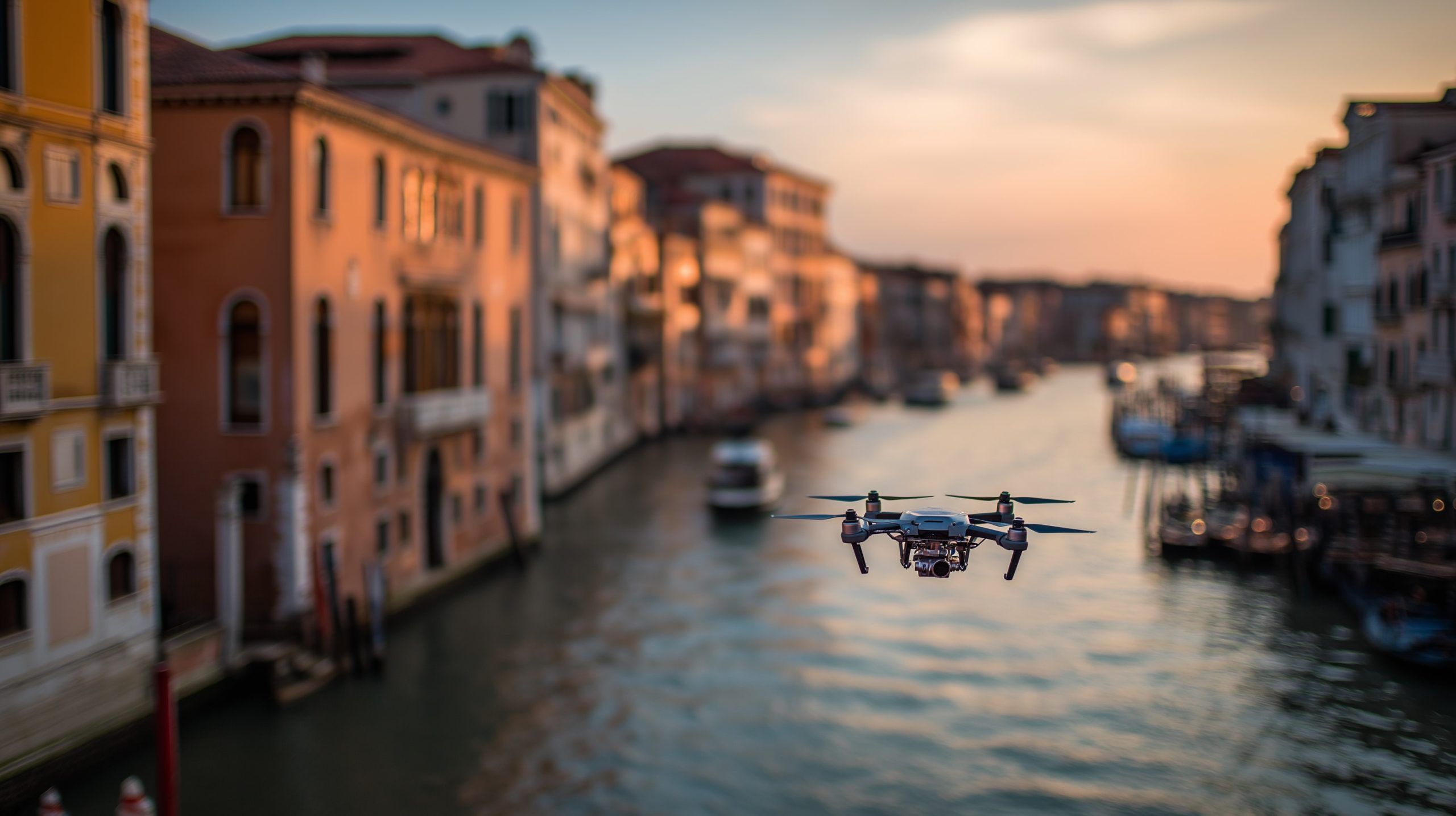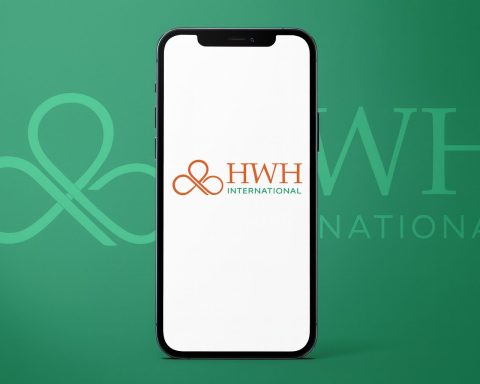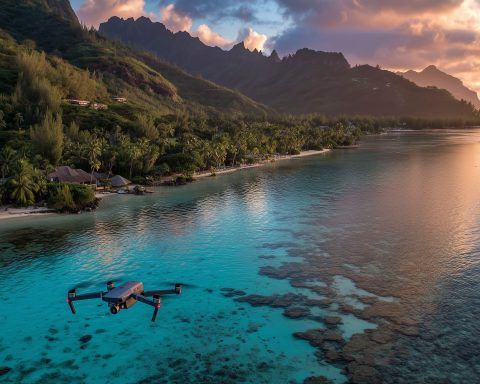- Venice’s historic center is effectively a no-fly zone that requires explicit ENAC and local authorities’ authorization, with the D-Flight map marking Venice in red as prohibited.
- The EU/ENAC altitude limit is 120 m (400 ft) above ground level, but in Venice’s restricted zones the practical limit without a permit is 0 m.
- Drones must stay away from airports and helipads, with no-fly restrictions within 5 km of an airport unless special clearance is granted.
- Flying near Venice Marco Polo Airport and the Lido airfield is forbidden without formal air traffic control permission.
- To fly in Venice, you must obtain ENAC authorization coordinated with local authorities, typically limited to professional film crews, emergencies, or research.
- Under EU rules, central Venice is treated as a specific-risk area, requiring at least an A2 competency and ENAC operating authorization rather than open-category flight.
- All drones over 250 g or with a camera must be registered with ENAC via the D-Flight portal, and an operator ID must be displayed on the drone.
- Italy requires third-party liability insurance for drones over 250 g, and flying uninsured can lead to fines and immediate grounding.
- Fines for illegal drone flights in Italy range from about €500 to €64,000, with maximums sometimes cited as €113,000, and police can confiscate the drone on the spot.
- Enforcement in Venice has included a 2016 St. Mark’s Square drone confiscation after a crash and a May 2022 Doge’s Palace incident where a drone was seized.
Overview: Drones in Venice – Strict Rules for a Historic City
Flying a drone in Italy is legal in general, but every flight must comply with national regulations set by the Italian Civil Aviation Authority (ENAC) and the EU’s drone rules (EASA) [1]. Venice, however, is a special case: the entire historic city is essentially a “no-fly zone” without prior authorization [2]. This applies to both recreational hobbyists and commercial operators. In practical terms, casual recreational drone use is banned over Venice’s city center, while commercial flights may be possible only with special permits from ENAC (and often the city authorities) obtained before you fly [3]. Venice’s unique geography (narrow canals, dense crowds, fragile historic buildings) has led to some of the tightest drone restrictions in the world. Below is a comprehensive breakdown of the laws and guidelines you must know before even thinking about launching a drone in or around Venice.
No-Fly Zones, Altitude Limits & Privacy Restrictions in Venice
Venice’s skyline might be picturesque, but most of it is off-limits to drones. Key restrictions include:
- Historic Center No-Fly Zone: Venice’s entire historic core (including famous sites like Piazza San Marco and the Grand Canal) lies in a restricted zone where drone flights are generally prohibited [4]. In fact, Italy’s official drone airspace maps (via the D-Flight portal) show the allowed altitude over most of Venice as 0 meters – essentially a blanket ban [5]. You cannot fly over St. Mark’s Square or any densely populated tourist area without explicit permission. Venice is classified as an Aerodrome Traffic Zone (ATZ) due to nearby airports and an “urban zone,” meaning nearly all of the city requires ENAC authorization to fly [6].
- Airport and Helipad Zones: By law, you must keep well away from airports. No drones are allowed within 5 km of an airport without special clearance [7]. Venice Marco Polo Airport’s airspace and the local Lido airfield cover large parts of the lagoon; flying here is forbidden unless you have formal air traffic control permission. Always check the ENAC/D-Flight maps for aeronautical restrictions before flying [8].
- Altitude Limits: Under EU/ENAC rules, the maximum legal altitude for drones in Italy is 120 m (400 ft) above ground level [9]. (Older Italian rules were even stricter at 70 m [10], but current EU harmonized limits allow 120 m). In Venice’s restricted zones, the practical limit is 0 m without a permit [11]. Even outside the city, never exceed 120 m and obey any lower local altitude caps in special zones (these will be indicated in D-Flight or NOTAMs).
- Crowded Areas & Touristic Sites: It is illegal to fly over groups of people or “assemblies”. Crowded plazas, busy streets, or queues of tourists are strictly off-limits to drone overflight [12]. Venice’s attractions (St. Mark’s Basilica, Doge’s Palace, Rialto Bridge, etc.) draw crowds, making it impossible to legally fly above them without endangering “uninvolved people” – which is banned in the open category of drone operations [13]. Bottom line: no buzzing over tourists or residential neighborhoods.
- Privacy Considerations: Italy has strong privacy laws, and pilots must respect people’s privacy and property. You should not film or photograph individuals without consent, especially not on private terraces or inside homes. In Venice’s dense urban setting, residents have complained about drones peeking into private spaces [14]. Flying low over private courtyards or windows can violate privacy laws and may result in police intervention. Always keep a reasonable distance from buildings and people to avoid any perception of snooping.
- Other Sensitive Areas: Italian regulations also forbid flights near sensitive infrastructure – stay away from military sites, hospitals, government buildings, ports, and utilities [15]. Venice’s historic buildings are considered part of the cultural heritage; any risk of harming them (even by accident) is taken very seriously by authorities. For example, flying over archaeological or heritage sites is banned without special permission [16]. Essentially, assume all of central Venice and its landmarks are a no-fly zone unless you have documentation saying otherwise.
Penalties & Enforcement: Breaking the Rules Will Cost You
Do NOT take Venice’s drone ban lightly. Italian authorities enforce drone laws in Venice with zero tolerance, and the penalties are severe. If you violate drone regulations, you could face:
- Hefty Fines: Fines for illegal drone flights in Italy range from a few hundred euros to tens of thousands. In typical cases, penalties can start around €500 and go up to €64,000 depending on the severity of the violation [17]. For example, flying without proper registration or in a restricted area might incur a fine in the lower thousands, while endangering people or aircraft can draw five-figure fines [18]. In extreme scenarios, Italian media have cited maximum fines as high as €113,000 for drone breaches [19]. The law is designed to deter reckless behavior with punitive fines – even a mid-range fine (€1,000–€5,000) can easily ruin your vacation.
- Drone Confiscation: If caught, expect the police to seize your drone on the spot. Venetian law enforcement is empowered to confiscate equipment used in illegal flights [20]. Often, the drone will be held as evidence and you may not get it back – especially if a court case is involved [21]. This means your pricey UAV could end up locked in an evidence room indefinitely or even forfeited to the state [22]. It’s not uncommon for travelers to leave Italy minus their drone after an infraction.
- Criminal Charges: Serious violations can lead to criminal penalties. Italian law (for instance, Article 733 of the Penal Code) provides for criminal charges if a drone flight damages or even risks damaging cultural heritage [23]. Crashing a drone into a protected monument could therefore be treated as a crime, not just an administrative offense. Likewise, flying in a way that endangers aircraft (e.g. in an airport flight path) can invoke criminal “air safety” charges. Jail time is rare but possible for egregious acts (for example, one man who flew a drone 2,000 m high over Rome was charged with “attacking transport security” [24]).
- On-the-Spot Enforcement: Venice’s police (including local police and national authorities) are on alert for illegal drones, especially in tourist areas. Officers patrol popular sites and will intervene if they spot a drone or receive reports from the public. They have the authority to demand your documentation, issue fines, and ground your drone immediately. There are reports of police in Venice arriving swiftly – even by boat – to stop rogue drones and question pilots (often tipped off by security cameras or bystanders). It’s worth noting that police may also delete your footage if it was obtained illegally, as part of the evidence/procedure [25].
- Legal Process: If you are cited for a violation, you might be required to pay the fine before leaving the country, or you could face legal proceedings. Cooperation can sometimes help (for instance, showing remorse might lead to a lesser fine), but arguing or fleeing will end badly [26]. Italy can also pursue foreign offenders via international mechanisms for unpaid fines [27], so don’t expect to evade punishment simply by going home. In short, breaking Venice’s drone rules can not only cost you money and your equipment – it can entangle you in legal troubles across borders.
Enforcement Example – Venice: In 2016, a tourist attempting to film Venice learned the hard way how strict these laws are. His camera drone crashed into St. Mark’s Square (luckily not injuring anyone) and landed near patrolling officers. Police confiscated the drone, and the tourist was fined (exact amount undisclosed). Authorities noted that flying drones in Venice was banned and that such offenses could be punished with fines up to €113,000 under aviation law [28] [29]. Another case: In May 2022, a drone fell into the Doge’s Palace courtyard after the pilot lost control. Firefighters had to retrieve it from the historic building’s roof, and the drone was handed over to Venice’s local police [30] [31]. The owner, likely a tourist, faces a hefty sanction – unless they somehow held a special flight permit (which is rare) [32]. These incidents highlight that Venice is under constant watch: if you attempt an unauthorized flight, chances are you will be spotted, your drone confiscated, and a fine (or worse) will follow.
Italian Drone Laws (ENAC/EASA) and How They Apply in Venice
Venice’s drone restrictions don’t exist in a vacuum – they are an outgrowth of Italy’s national drone laws combined with special protections for historic city areas. Here’s how the broader rules play out:
- National Framework: Italy follows the EU-wide drone regulations implemented by EASA (in effect since 2021) [33]. These regulations divide drone operations into categories (Open, Specific, Certified) based on risk. Most tourist or hobby flights fall into the “Open” category, which has strict conditions: you must keep visual line-of-sight, stay under 120 m altitude, not fly over uninvolved people (unless your drone is very small), and stay clear of “no-go” zones [34] [35]. Italy, through ENAC, also sets some additional national rules (for example, requiring registration of drones with cameras, and mandating insurance – more on that below).
- Urban and “Critical” Operations: Under both EU and Italian rules, flying over “congested areas” or gatherings of people is prohibited in the Open category [36]. Any operation in a busy city center is considered higher risk. ENAC used to label these as “critical operations,” requiring a special permit. With EASA’s framework, such flights now would fall under the Specific category, meaning you need explicit authorization (with a risk assessment) to fly over an urban area like Venice. Practically, a tourist with a drone cannot meet these requirements, and thus cannot legally fly in Venice’s populated areas without going through a formal permit process.
- Venice’s Special Status: Because Venice is both densely populated and of immense cultural importance, Italian authorities have effectively made it a permanent geographical no-fly zone. It is within controlled airspace and subject to security restrictions. For instance, Venice’s city area is within an Aerodrome Traffic Zone (likely due to the Venice-Lido “Nicelli” airport nearby) [37]. Also, as a UNESCO World Heritage site, it receives extra protection – similar to bans in place over Rome’s ancient sites or Florence’s center. In practice, Rome, Florence, Venice and other historic city cores are all covered by no-fly zones to protect people and heritage [38]. This is reflected on official maps: D-Flight clearly marks Venice in red as a prohibited area [39]. So, while Italy’s general law might allow drones in many places, it excludes places like Venice unless you have clearance.
- Getting Authorization in Venice: Gaining permission to fly in Venice is deliberately difficult. You would need to apply through ENAC well in advance, providing a strong justification (simply wanting cool vacation footage will be denied [40]). ENAC coordinates with local authorities (the Venice Prefecture, police, etc.) to evaluate requests [41]. Only pilots with proper certification and purpose (e.g. professional film crews, emergency services, research projects) stand a chance of approval [42] [43]. Even then, flights may be allowed only at certain times (e.g. dawn, when few people are around) and with safety measures like spotters on the ground [44]. Venice’s Prefect can outright ban all drones during special events (Carnival, the Redentore festival, etc.) [45], and often does so via public safety ordinances. In summary, the default is “NO,” and only in exceptional cases will ENAC say “yes” to a Venice drone flight.
- EU Categories Recap: To put it simply, any flight in central Venice would not qualify as a low-risk Open category operation – it would be considered “specific” risk. That means the pilot would need to have at least an A2 or higher competency, and an operational authorization from ENAC. Hobbyists flying in Open category (A1/A3) are restricted to areas “far from people” – which Venice is not [46] [47]. The rules requiring a 150 m horizontal distance from residential, commercial, or recreational areas for larger drones (in category A3) basically rule out flying in any town or city [48]. Even for a small drone (under 250g in A1 category), while you can fly over people incidentally, you still cannot fly in a no-fly geographic zone like Venice without permission [49]. So, European law plus Italy’s geofencing have effectively sealed off Venice’s skies except for approved uses.
Registration, Permits, Licensing & Insurance Requirements
If you do plan to operate a drone in Italy (whether outside Venice, or with a permit in Venice), you must comply with all paperwork and credential rules. Key requirements include:
- Drone Registration (Operator ID): Italy mandates that all drones over 250 g, or any drone with a camera, be registered with ENAC before flying [50]. This is done through the D-Flight online portal, where you obtain a unique Operator Registration number [51] [52]. This operator ID must be displayed on your drone (usually as a sticker or QR code). Essentially, if you’re a foreign visitor, you’ll need to register as an operator in Italy/EU (via D-Flight or your home country’s equivalent) and mark your drone with the ID number [53]. Note: Even many sub-250g drones (like a DJI Mini) carry a camera, which means they do require registration despite their weight, because of EU privacy rules [54]. (Toy drones under 250 g with no camera are the only exception.) Failing to register can lead to fines and will invalidate any permission request.
- Drone Pilot License/Certificate: For any drone above 250 g, or for any drone operation beyond the most minimal risk, you need a drone pilot competency certificate. Italy adheres to the EASA certification system. At minimum, most pilots need to pass the basic online exam for A1/A3 category to get a Remote Pilot Certificate (proof of competency) [55]. This involves studying drone rules and safety and taking an online test (often available in English). If you intend to fly closer to people or in controlled situations (e.g. using a drone up to 2 kg in category A2), you’d also need the A2 certificate which requires additional training/exam. In short, don’t fly in Italy without having the appropriate pilot license on hand – authorities may ask to see it if they stop you. For non-EU citizens, Italy will recognize equivalent EASA certificates (you might need to take an online course if you haven’t already). There is no separate “Italy-only” license – the EASA license is sufficient and valid across the EU [56] [57]. However, carrying proof of your pilot qualifications is important, especially if you’re seeking any special flight permission.
- Flight Permits (Authorizations): As discussed, flying in Venice’s restricted area requires a specific permit from ENAC (and usually local authorities). To obtain this, a pilot typically must submit an application well in advance, including details like: pilot qualifications, drone specs, purpose of flight, exact location and time, safety measures, and insurance proof. For professional shoots, often a local film commission or the city council’s office needs to be involved to get location permits as well [58]. Expect bureaucracy – multiple levels of approval. For most tourists, this is not feasible. Permits are more commonly granted to film productions, researchers, or public agencies. Also note: even commercial pilots doing “low-risk” jobs elsewhere in Italy must at least file a statement of compliance with ENAC and pay a fee, or get a full operating certificate for higher risk work [59]. So, any commercial use has additional paperwork. Important: If you somehow have secured ENAC authorization to fly in Venice, carry the approval documents with you during the operation – you will need to show the police that you’re not just another rogue drone user.
- Insurance: Italy has a strict insurance requirement. No drone (UAS) may be operated in Italy without adequate third-party liability insurance [60]. This means you need an insurance policy that covers any damage or injury your drone might cause on the ground or to other aircraft. All operators flying drones over 250 g must have liability insurance in Italy [61]. (Even under 250 g, it’s strongly recommended, and some sources suggest insurance is effectively required if the drone has a camera.) Many Italian pilots use specialized drone insurance policies. Foreign pilots should obtain an international drone liability policy that meets EU standards (Reg. EC 785/2004) – some travel insurance or drone associations offer this. Expect authorities to ask for proof of insurance if you get caught in an incident. Flying without insurance is not only illegal [62], but also dangerous: if your drone crashes into a historic statue or hurts someone, you would be personally liable for all damages. ENAC considers lack of insurance a serious offense – if caught uninsured, you can be fined and grounded immediately [63]. In sum, don’t take off in Italy until you’re insured; it’s for your own protection and it’s the law.
- Drone Markings & Equipment: By law, your drone should have an identification plate with your details (this is fulfilled by the operator ID sticker) [64]. As of 2024, new drones in Europe are coming with class labels (C0, C1, etc.) which indicate what category they can fly in [65]. If your drone is an older model without a class mark, note that from 2024 onward it will be treated more strictly (most legacy drones >250 g are limited to only flying in A3 “far from people” category) [66]. Also, Remote ID requirements are being phased in – eventually drones will need to broadcast an electronic ID. Keep an eye on ENAC updates for any mandates on Remote ID device usage in Italy’s cities. While these technical details may not be immediately checked by police on the street, they are part of staying compliant. Always ensure your drone firmware is up-to-date and that any required geo-fencing unlocks or permissions (if you do have ENAC authorization, for example) are obtained in advance. DJI’s geofence map will flag Venice as a restricted zone; you cannot even take off with a DJI drone there unless you have proof of authorization to unlock it.
Best Practices for Legal & Safe Flying (In or Near Venice)
If you’re determined to fly a drone legally in Venice or anywhere nearby, follow these best practices to stay on the right side of the law and out of trouble:
- Avoid Central Venice – Fly in Safe Zones: The simplest advice is do not fly in Venice’s historic center at all unless you have written authorization. Instead, consider flying in designated safe areas well outside the city. For hobbyists, this might mean going to open countryside on the mainland or finding an authorized model airfield. Always consult the D-Flight map for green zones where flight is allowed, and respect all red/orange no-fly zones [67]. If you’re staying in Venice, you might be tempted by a beautiful sunrise shot over the canals – but remember it’s illegal. A legal alternative could be hiring a local licensed drone operator who has permits to capture footage, or using licensed drone footage from stock libraries. Don’t risk an unauthorized flight in Venice – the scenic view isn’t worth a €5,000+ fine.
- Follow General Flight Rules Rigorously: Even outside no-fly zones, always adhere to Italy’s general drone rules. Keep your drone within visual line-of-sight (VLOS) at all times [68] – don’t fly beyond where you can see it. Fly only in daylight (night flights are prohibited without special permission) [69]. Maintain a safe distance from people and property – as a guideline, stay at least 50–150 m away from people and built-up areas if flying a larger drone [70]. Never fly over crowds, roadways, or sensitive sites [71]. Stay below 120 m altitude always [72]. And never fly under the influence of alcohol or while distracted. These basics will not only keep you legal but also greatly reduce the chance of accidents.
- Use a Spotter and Safety Measures: If you do have permission to fly in or near Venice (for example, an early morning shoot in a less populated area), take extra safety precautions. It’s wise to have a second person as a spotter watching the drone and the surroundings for any issues. Professionals in Italy often work in teams – one piloting, others monitoring pedestrian traffic to prevent overflight of people [73]. Make sure to cordon off the takeoff/landing area so no one wanders under the drone. Check your drone’s failsafe settings (Return-to-Home, etc.) and ensure it has a strong GPS signal to avoid fly-aways in the maze of Venice’s alleys. Given the prevalence of water, consider installing floatation devices if flying over canals or the lagoon, and always be prepared for a water landing (carry a waterproof retrieval bag or have a plan). Essentially, go above and beyond with safety when operating in complex environments.
- Stay Informed (Check NOTAMs and Updates): Regulations can evolve, and temporary flight restrictions pop up. Always check for local NOTAMs (Notices to Airmen) before flying – there could be a temporary ban due to a VIP visit or an event. Monitor ENAC’s website and the D-Flight portal for any recent rule changes or announcements specific to the Venice area. For instance, during the Venice Film Festival or high-profile weddings/events, authorities often issue blanket drone bans (even for licensed pilots) [74]. By staying informed, you won’t be caught off guard. If in doubt, contact ENAC or local authorities to clarify if an area is okay to fly. It’s better to ask permission than to beg forgiveness in Italy – the latter could mean confiscation and fines.
- Respect Privacy and Locals: Venice is a living city with residents who value their privacy. Do not hover over private homes, hotel balconies, or people in gondolas even if you’re flying outside the strict no-fly zones. Italian privacy laws give people the right to not be filmed or photographed in a intrusive way. So, avoid using your drone camera in a way that could be seen as spying. If someone approaches you with concerns, be polite and land your drone. Earning the ire of locals can quickly lead to police involvement. Always err on the side of courtesy and caution – fly in open areas, at respectable heights, and point cameras away from individuals not involved in your project.
- Carry Documents & ID: Whenever you fly in Italy, keep all your documents on you: registration certificate, proof of insurance, your pilot license, and any special permit if applicable. Also carry ID (passport or Italian ID). If police approach, you want to be able to immediately show that you’re trying to do things by the book. Having documentation won’t save you if you’re blatantly breaking the rules, but if you’re in a gray area, it can demonstrate good faith. Enforcement officers will take a much harsher stance if you appear to be an uninformed or negligent operator. On the other hand, showing that you’ve registered, insured, and educated yourself can sometimes lead to a bit of leniency or at least a more professional interaction.
- Plan Flights Meticulously: Don’t improvise when flying near a sensitive place like Venice. Plan your flight path, check the weather (winds in Venice can be tricky along canals), and have a short flight duration (get your shots and land promptly). The longer your drone loiters, the more likely it will attract unwanted attention. Early mornings shortly after sunrise often have the fewest people around – a safer time if you have permission to fly (and smoother air). Avoid busy weekends or holidays. Keep your drone in “Beginner” mode or geofence it to a tight radius if you’re flying from a boat or near the city limits, so it doesn’t accidentally drift into forbidden zones. Essentially, be the opposite of the “reckless tourist” stereotype: be the pilot who knows the rules, uses common sense, and prioritizes safety.
Recent Updates & Notable Drone Incidents in Venice
Drone regulations have evolved in recent years, and Venice has seen a few high-profile cases that underscore these laws:
- EU Rule Updates (2021–2024): Italy updated its drone laws on January 1, 2021, to align with the new EASA framework, and further tweaks came into effect in 2024. One big change is the end of the “transitional” period for older drones in 2024, meaning if your drone lacks a class identification label, it is now restricted to more stringent flying categories [75]. Additionally, Remote ID requirements are being introduced – new drone models are coming with built-in broadcasting of ID info, and by 2026 all drones may need to comply. ENAC has also rolled out the D-Flight system for real-time airspace data and digital flight plans. Pilots should use these tools to stay updated. While these changes are technical, the takeaway is that the regulatory net is tightening – authorities have better tools to identify drones and pilots, and the expectations for compliance are higher than ever.
- Venice–ENAC Cooperation: In March 2021, the City of Venice signed a protocol with ENAC to develop Urban Air Mobility and drone delivery experiments in the region [76] [77]. This doesn’t mean drones can suddenly roam free – rather, it’s a controlled testing initiative. The focus is on finding ways to use drones for public good (like medical supply deliveries to the islands) while protecting Venice’s “fragile” historic environment [78]. Any such flights are carried out by authorized operators in coordination with the city. The average visitor’s drone is still not allowed. However, this shows Venice is looking to the future: it wants to integrate drones in beneficial ways (e.g., inspecting monuments after storms [79], or transporting goods to reduce boat traffic) without harming its heritage. There may be designated corridors or vertiport infrastructure in the coming years as part of this plan [80], but until then the ban for general use stands.
- Incidents in Venice: Beyond the 2016 St. Mark’s Square crash and the 2022 Doge’s Palace incident already mentioned, there have been multiple tourist drone mishaps across Italy in recent times – and Venice is no exception. In 2019, local media reported various illegal drone flights in Venice as tourism rebounded, prompting police crackdowns [81] [82]. In one case, a tourist was fined approximately €2,000 for flying a drone over Venice without permission (widely discussed in Italian drone forums). The phrase “droni, il centro storico di Venezia è una grande no fly zone, ma in molti lo ignorano” – “drones, Venice’s historic center is one big no-fly zone, but many ignore it” – made headlines in Venice [83]. Each year, especially in summer, a few visitors learn about the drone ban the hard way. The pattern is usually the same: an unwitting tourist launches a drone for a quick photo, within minutes police officers approach (often alerted by residents or cameras), and the drone is confiscated and a fine issued. These incidents are highly publicized to dissuade others. Venice officials have even used social media and signage to spread the message that “No Drone Zone” means NO DRONES.
- Nationwide Context: Italy overall has seen a string of drone-related infractions at tourist sites. In 2022, an Argentinian tourist crashed a drone into Rome’s Palazzo Venezia and was reported to face a fine between €500 and €68,000 [84]. In 2020, a tourist from Poland famously crashed a drone inside the Colosseum in Rome after ignoring warnings [85]. And in 2023, two foreign pilots were criminally charged for flying over the Colosseum at night. While these aren’t Venice-specific, they contribute to Italy’s aggressive stance on protecting heritage cities. Venice, being smaller and even more fragile, is arguably under even greater scrutiny. The Italian press regularly covers these stories to reinforce that violating drone laws is a serious offense, not a trivial matter.
- COVID-19 Period: Interestingly, during the 2020 pandemic lockdowns, Venice’s empty streets tempted some drone operators to fly (with permission) to document the deserted city. ENAC did authorize a few flights for journalism and research when no people were around. This yielded stunning footage of Venice in lockdown – but these were exceptional circumstances. Once tourism returned, so did the restrictions. The brief window when “a dozen drones” were seen over Venice with authorization [86] was an anomaly due to zero crowds. It does show that ENAC can grant permits (with a valid reason like news gathering), but under normal conditions the answer reverts to “no” for most applicants.
In conclusion, Venice’s drone laws are among the strictest you’ll encounter. The combination of national rules and local no-fly zones means the city is virtually off-limits to casual drone use. Always assume you cannot fly in Venice unless you have jumped through all the legal hoops – and even then, exercise extreme caution. The safest approach for drone enthusiasts visiting Venice is to enjoy the city from the ground, and maybe fly your drone in less sensitive areas of Italy where it’s permitted. The penalties for mistakes here are just too high, and the authorities have made it clear that protecting Venice’s skies is a top priority. Fly safe and legally – or not at all – when it comes to the Queen of the Adriatic.
Sources: Venice and Italy drone law information has been compiled from official guidelines and reputable sources including ENAC and EASA regulations, the D-Flight no-fly zone maps [87], news reports from The Local Italy [88] [89], drone industry experts [90] [91], and Italian media coverage of drone incidents and laws [92] [93]. These illustrate the current legal landscape (as of 2025) for operating drones in Venice. Always double-check the latest rules with ENAC or official publications before flying, as regulations can update over time. Enjoy Venice responsibly – from the ground!
References
1. www.saturdaysinrome.com, 2. www.saturdaysinrome.com, 3. www.flyingglass.com.au, 4. www.flyingglass.com.au, 5. www.dronezine.it, 6. www.saturdaysinrome.com, 7. www.dji.com, 8. www.enac.gov.it, 9. www.flyingglass.com.au, 10. www.thelocal.it, 11. www.dronezine.it, 12. www.saturdaysinrome.com, 13. www.saturdaysinrome.com, 14. www.nuovavenezia.it, 15. www.saturdaysinrome.com, 16. www.saturdaysinrome.com, 17. www.saturdaysinrome.com, 18. ts2.tech, 19. www.thelocal.it, 20. www.flyingglass.com.au, 21. ts2.tech, 22. ts2.tech, 23. ts2.tech, 24. www.saturdaysinrome.com, 25. www.reddit.com, 26. ts2.tech, 27. ts2.tech, 28. www.thelocal.it, 29. www.thelocal.it, 30. www.dronezine.it, 31. www.dronezine.it, 32. www.dronezine.it, 33. www.saturdaysinrome.com, 34. uavcoach.com, 35. uavcoach.com, 36. uavcoach.com, 37. www.saturdaysinrome.com, 38. www.dronelicense.eu, 39. www.dronezine.it, 40. www.nuovavenezia.it, 41. www.nuovavenezia.it, 42. www.nuovavenezia.it, 43. www.nuovavenezia.it, 44. www.nuovavenezia.it, 45. www.nuovavenezia.it, 46. ts2.tech, 47. ts2.tech, 48. ts2.tech, 49. www.flyingglass.com.au, 50. ts2.tech, 51. www.saturdaysinrome.com, 52. ts2.tech, 53. www.saturdaysinrome.com, 54. ts2.tech, 55. ts2.tech, 56. www.flyingglass.com.au, 57. www.flyingglass.com.au, 58. www.flyingglass.com.au, 59. uavcoach.com, 60. www.elgaronline.com, 61. www.flyingglass.com.au, 62. www.enac.gov.it, 63. ts2.tech, 64. uavcoach.com, 65. ts2.tech, 66. ts2.tech, 67. www.enac.gov.it, 68. www.saturdaysinrome.com, 69. www.flyingglass.com.au, 70. uavcoach.com, 71. www.saturdaysinrome.com, 72. www.flyingglass.com.au, 73. www.nuovavenezia.it, 74. www.dronezine.it, 75. ts2.tech, 76. live.comune.venezia.it, 77. live.comune.venezia.it, 78. live.comune.venezia.it, 79. www.dronezine.it, 80. live.comune.venezia.it, 81. www.nuovavenezia.it, 82. www.nuovavenezia.it, 83. www.nuovavenezia.it, 84. ts2.tech, 85. www.saturdaysinrome.com, 86. www.nuovavenezia.it, 87. www.dronezine.it, 88. www.thelocal.it, 89. www.thelocal.it, 90. www.flyingglass.com.au, 91. www.flyingglass.com.au, 92. www.saturdaysinrome.com, 93. ts2.tech










